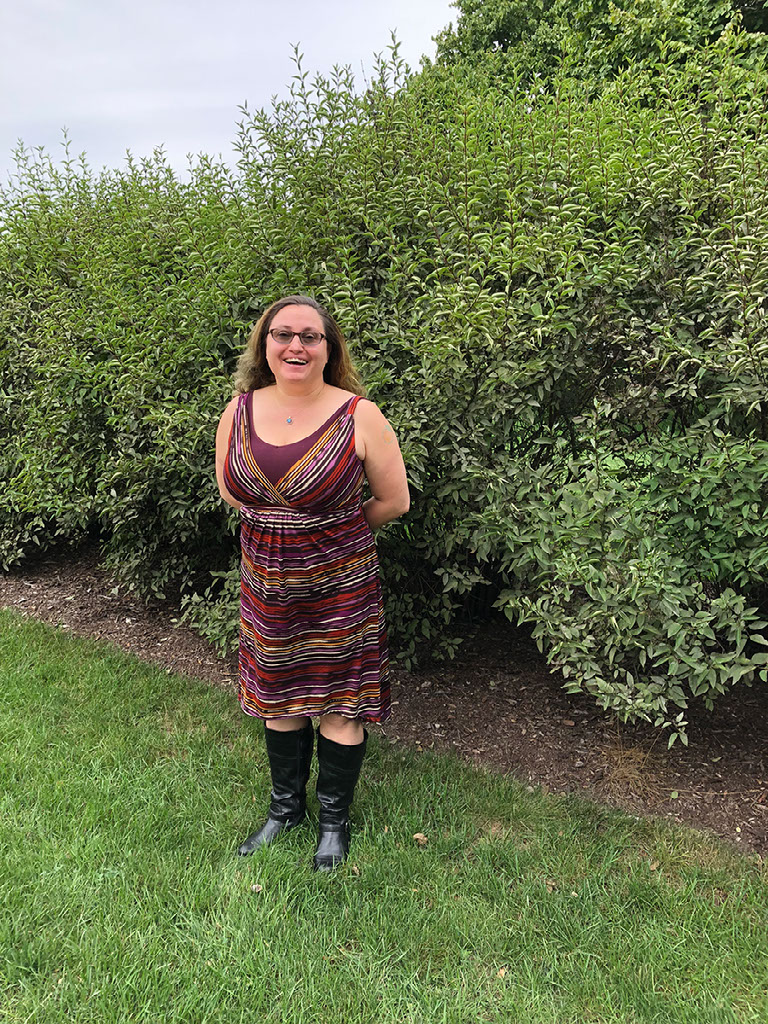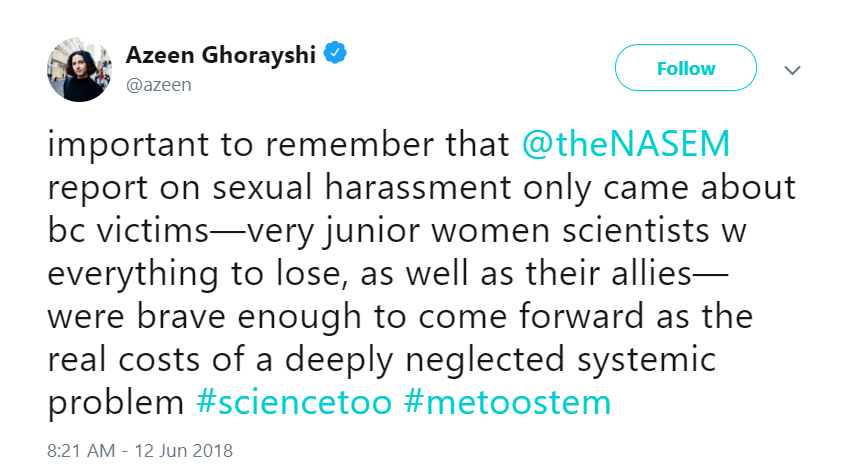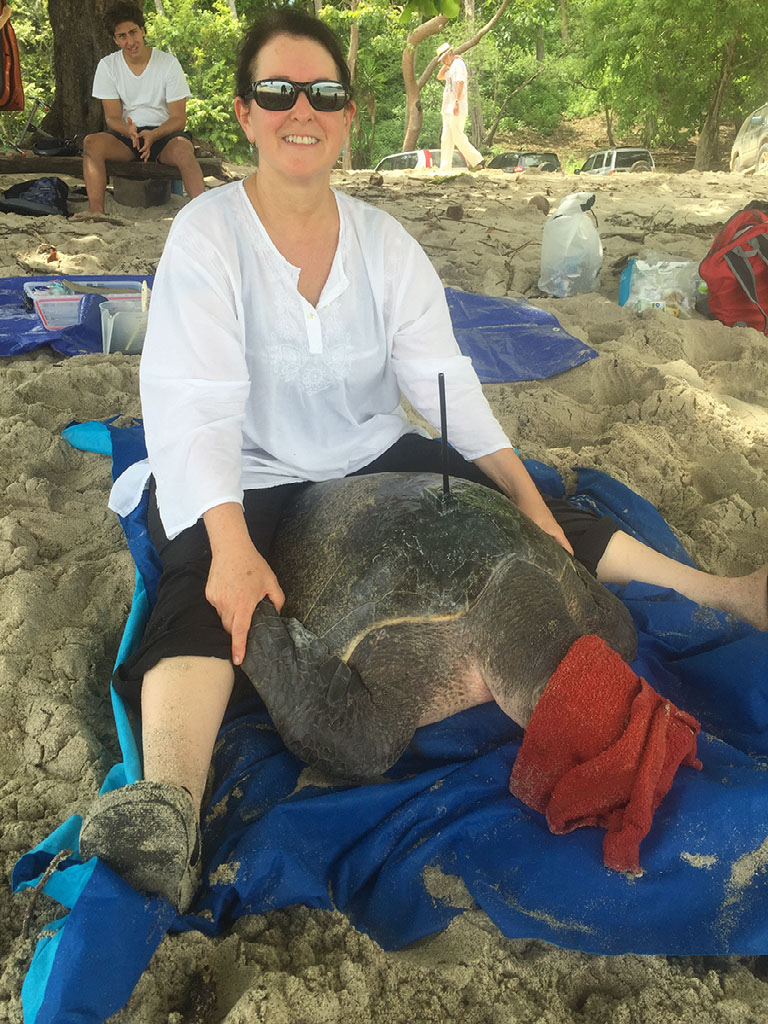Why academia needs its #MeToo moment
Academia reports the second-highest rates of work-related sexual harassment, only less than the military
Content warning: this article contains descriptions of sexual harassment and assault.
One night while attending a retirement party for a colleague, Julie Libarkin, was sexually assaulted in the middle of the gathering.
The associate professor of geocognition and tectonics at Michigan State University says an emeritus professor snuck behind her, bent his knee and humped her. No one said a word.
Libarkin, who now heads MSU’s Geocognition Research Laboratory, wrote about the experience in the blog #MeTooStem, which she runs with another scientist, BethAnn McLaughlin, an associate professor of neurology at Vanderbilt.
“This happened in front of other people,” she wrote, “and the response was about what you would expect. No one jumped in to rescue me, and no one seemed to have realized that I had just been assaulted." She didn't report the assault at the time, but says she can today, explaining, "I am privileged to be a professor and in a position where my anonymity isn’t a problem.”

Julie Libarkin keeps a database of sexual misconduct cases in academia.
This wasn’t an isolated incident for Libarkin. Nor is this type of harassment uncommon in STEM fields, though the #MeToo movement has been slow to reach academia. But a 2006 meta-analysis of work-related sexual harassment found an astonishing 58 percent of female faculty and staff in academic institutions have been sexually harassed—second only to the military, at 69 percent.
Since the launch of the #MeTooSTEM blog in early June, dozens of women have, mostly anonymously, submitted stories documenting their worst moments, fears, and reactions to sexual harassment. Even before the launch of #MeTooSTEM, Libarkin tediously kept tabs on sexual misconduct cases in academia, creating a database of cases housed on her lab’s website. In just over two years, her records have grown to more than 700 cases.
“Most women I know have been harassed,” she told the blog The Marjorie, “so I decided to document what I could find.” She also takes pains to point out that while #MeToo is bringing sexual harassment into the spotlight, sexual harassment in academia isn't exactly news. “How many more were never reported because, let’s be honest here, what’s the point if the crimes are barely punished and people are hired elsewhere anyway?” Libarkin wrote in a blog post on her lab’s website.
Indeed, most women don’t report harassment, according to a new report by the National Academies of Science, Engineering and Medicine.
“If you look at the research, reporting is basically the least likely behavior,” said Ashley Bear, a co-principal investigator on the report and a program officer for NASEM. Bear explains sexual misconduct frequently goes unreported because victims (rightfully) fear retaliation or damage to their career. That's why she says encouraging reporting is not always the best approach. Instead of placing the burden on victims, institutions should focus on creating environments that are not conducive to harassment.
The #MeToo movement was created by Tarana Burke in 2007, but didn't go viral until 2017. Bear's research started in late 2016 and its publication in June revived the hashtags #MeTooSTEM and #ScienceToo. She hopes to raise awareness of women and other underrepresented populations in STEM fighting against systemic gender inequality and sexual harassment.

Not All Harassment is Sexual in Nature
The report classifies three categories of sexual harassment: gender harassment, unwanted sexual attention, and sexual coercion.
Gender harassment—the “verbal and nonverbal behaviors that include hostility, objectification, exclusion or second-class status about members of one gender”—is the most pervasive, and is not necessarily sexual in nature, according to the report.
Career scientists like Pam Plotkin, director of the Texas Sea Grant College Program, say this type of sexual harassment is so common, women often do not realize it’s harassment at all. Plotkin says gender harassment can be very subtle, including "demeaning behavior where you’re dismissed, [or] people talk on top of you at meetings or in one-on-one conversations.” (Disclosure: The author of this article works for Florida Sea Grant, but does not personally know Plotkin.)
As as an up-and-coming sea turtle biologist in the early ‘90s, Plotkin explains she witnessed this kind of harassment first-hand. In those days, professional meetings felt more like a “good ol’ boys” club than a valuable networking event for women in the field.
“Women who did discuss their concerns were dismissed and labeled as troublemakers,” she said. “There were very few opportunities for women to be in leadership positions back in those days."
”They were not represented on the editorial boards of journals. They were not represented on grant proposal review panels. Women were not represented in [scientific] societies.”

Sea turtle biologist Pam Plotkin sits with an olive ridley sea turtle, waiting for its satellite transmitter to dry.
Christine Figgener
Describing herself as having a “thick shell,” Plotkin said she learned to skip the boozy social events to avoid bad situations. But she also said she knows women who have been bullied even to the extent that they leave their field altogether. This is a difficult choice many women face—to find a way to ignore bad behavior, or to remove themselves from the situation, limiting their career.
The report defines a second type of harassment, unwanted sexual attention, as “verbal or physical unwelcome sexual advances, which can include assault.” The #MeTooSTEM blog is rife with uncomfortable examples. One anonymous post from a woman who called herself Sarah recounts when she attended her first conference as a graduate student. She was approached by a professor, and the two began making small talk about their research.
“I realized that he was moving closer to me and he suddenly interrupted with a question that I didn’t hear or understand properly,” Sarah writes. “Slightly uncomfortable, I said something to indicate this. He then took a step closer to me and said, very close to my ear: ‘perhaps you’re not as horny as I am yet’ and immediately pushed his hand against my stomach and down inside the front of my jeans and inside my underwear.
“I don’t know why I didn’t cry out, but I didn’t. Instead, I wrenched away in horror and ran to the ladies’ bathrooms, acting purely on instinct.”
The report's third classification is sexual coercion, or “when favorable professional or educational treatment is conditioned on sexual activity.” The legal term is quid pro quo sexual harassment. Examples include promises of a better grade or a letter of reference in exchange for sexual favors. According to the NASEM report, “Victims of sexual harassment experience declines in their professional, psychological, and physical well being.”
“I thought there was something I was doing to cause this behavior from men,” a woman posting under the name of Meredith writes anonymously on the #MeTooSTEM blog. “And my career has been plagued by feelings of self doubt and a fear of how my behavior makes men in my field feel. This has changed the way I approach presentations, collaborations and interacting publicly in my field.”
The impacts of sexual harassment in the STEM fields can be far-reaching. Women in science are certainly underrepresented in leadership roles. Take the field of medicine, for example: Women make up nearly 50 percent of medical school applicants, according to a report by the Leukemia and Lymphoma Society, yet only 16 percent of deans, 15 percent of department chairs and 21 percent of full-time professors are women.
File Cabinet Compliance
Thanks to decades of hard work by feminists and allies, there are laws in place—especially at universities—to protect employees from discrimination.
These laws include Title VII of the Civil Rights Act of 1964 and Title IX, which both prohibit discrimination and harassment based on sex. Title VII applies to faculty, staff and students, and Title IX applies to “any education program or activity receiving federal funds”—which is almost all academic institutions in the U.S.
But some say these laws aren’t working as intended.
“Too often, judicial interpretation of Title IX and Title VII has incentivized institutions to create policies and training on sexual harassment that focus on symbolic compliance with current law and avoiding liability, and not on preventing sexual harassment,” the NASEM report says.
In other words, policies are in place on paper, but research conducted by NASEM says they do not actually prevent sexual harassment.
“Legally, institutions are only required to show ‘file cabinet compliance’—the existence of policies on paper,” reads a report by the 500 Women Scientists, a nonprofit dedicated to making science more inclusive and accessible.
Bear says it’s time to go back to the drawing board and look at what factors contribute to environments in which sexual harassment thrives.
These factors include a perceived tolerance for sexual harassment, male-dominated work settings, work settings with hierarchical power structures and uninformed leadership, according to the NASEM report.
For many in academia, these factors seem all too familiar.
Next Steps
The first step toward safe spaces free of sexual harassment in academia is to create diverse, inclusive and respectful environments, and to address gender harassment, which is the most common form of harassment, according to the NASEM report.
The report also recommends that institutions stop relying solely on legal compliance to solve such problems.
“Basically all (legal compliance) incentivizes is the establishment of a policy that may or may not have any positive impact and could potentially have a negative impact,” Bear said.
The report also recommends that institutions improve transparency and accountability, diffuse hierarchical power structures, conduct more research and measure progress. A complete list of solutions is available on NASEM’s website.
“Science,” Bear said, “is not always a welcoming or supportive environment for women, people of color, persons with disabilities, sexual and gender minorities, and those with intersectional identities that cut across these demographic groups and others.
“But I believe we should not lose hope.”
This article was originally published on The Marjorie. Marjorie editor Anna Hamilton contributed audio production and Michael Stone contributed copy editing.